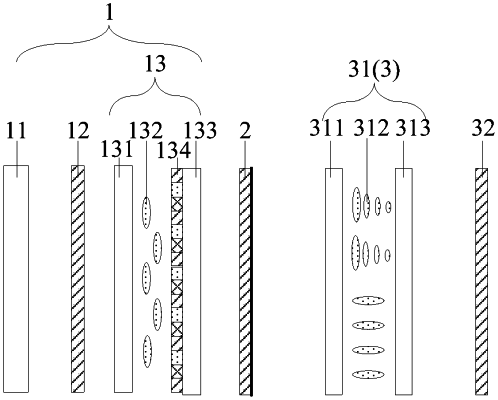| CPC G02F 1/1396 (2013.01) [G02F 1/13306 (2013.01); G02F 1/133531 (2021.01); G02F 1/133536 (2013.01); G02F 2203/02 (2013.01); G02F 2203/07 (2013.01)] | 11 Claims |

|
1. A display device, comprising:
a display component, comprising a plurality of display pixels arranged in an array;
a reflective polarizer, located on a light emitting side of the display component, having a light transmission axis, and configured to reflect light with a polarization direction perpendicular to a direction of the light transmission axis and allow light with a polarization direction parallel to the direction of the light transmission axis to pass through;
a first polarizer, located on a side, facing away from the display component, of the reflective polarizer, wherein a light transmission axis of the first polarizer is parallel to the light transmission axis of the reflective polarizer; and
a light control component, located between the reflective polarizer and the first polarizer, and having a plurality of light control pixels arranged in an array, wherein each of the light control pixels covers at least one of the display pixels, each of the light control pixels is configured to switch between a first state and a second state, when the light control pixel is in the first state, external ambient light passing through the first polarizer does not change a polarization state after passing through the light control pixel, and when the light control pixel is in the second state, the external ambient light passing through the first polarizer is adjusted, after passing through the light control pixel, to be linearly polarized light perpendicular to the direction of the light transmission axis of the reflective polarizer; wherein the display component comprises: a liquid crystal display panel; the light control component is a liquid crystal control panel, the first state is a state when a display pixel is required for display, and the second state is a state when a display pixel is not required for display; in the first state, a voltage is applied to a display pixel electrode and a first common electrode of the liquid crystal display panel, and a voltage is applied to a light control pixel electrode and a second common electrode of the liquid crystal control panel, so that the liquid crystal display panel converts the linearly polarized light into elliptically polarized light, and the liquid crystal control panel allows the light to pass through; in the second state, the voltage is not applied to the display pixel electrode and the first common electrode of the liquid crystal display panel, and the voltage is not applied to the light control pixel electrode and the second common electrode of the liquid crystal control panel, so that the display component does not emit light.
|